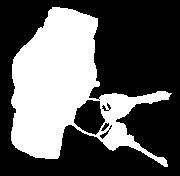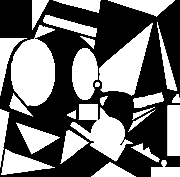Our eyes are trained to seek out positive shapes - recognizing a chair or coffee cup. In order to successfully master the skill of drawing, an artist has to rid of this habit, and look not only at positive shapes, but the negative space that surrounds them. All shapes, both positive and negative, are equally important. Together, they provide a composition with unity.
To clarify, the terms positive and negative can also be described using the following:
 To grasp a better idea of what this article details, try the following exercise:
To grasp a better idea of what this article details, try the following exercise:
Draw the silhouette of two joined objects to create a composite shape (one single form) Overlap the two objects in one or more areas to achieve enclosed positive and negative shapes.
You'll notice that the spatial difference between the objects will become distorted. One tall object placed before a shorter one, will appear further into the background and behind the shorter object. Minimizing the objects to positive and negative space results in a lack of spatial information to the eye, and images become distorted or misinterpreted.
 Step One: Create a quick, continuous-line drawing of a still life (ie. a watch and two keys).
Step One: Create a quick, continuous-line drawing of a still life (ie. a watch and two keys).
Step Two: Minimalize the actual shapes by reducing both positive and negative shapes to rectangles and squares. You will have to force the geometric shapes to fit the actual still-life forms.
Study the piece as you go along. Some shapes are merely implied, while others actually exist. Often, certain types of shapes will predominate.
Having a better understanding of how positive shapes and negative space unite to form a composition, will help you to create outstanding and striking works of art. Goodluck!